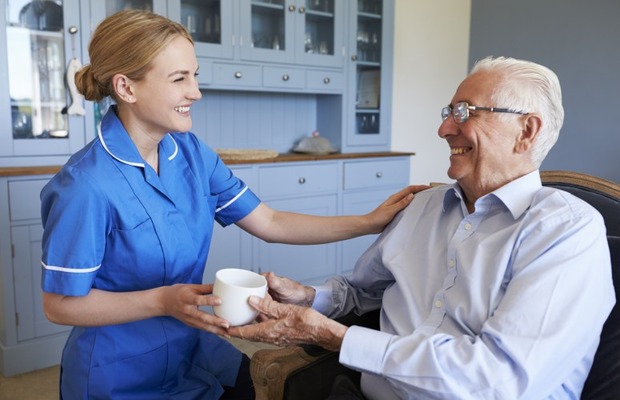
Home oxygen therapy
This page by the Leeds Community Respiratory team will give you more information on what you need to know about home oxygen therapy.

Home oxygen therapy: What you need to know
Home oxygen therapy is prescribed for people with chronic respiratory or cardiac conditions whose oxygen levels are persistently low. It can improve how long you live, reduce symptoms like breathlessness, and support daily activity and independence.
It’s important to remember, oxygen is given to treat low oxygen levels in your blood rather than to manage breathlessness.
This page explains who may benefit, how oxygen is delivered, and how to use it safely.
What is home oxygen therapy?
This treatment helps people whose bodies don’t get enough oxygen. It’s used for conditions like:
- Lung diseases (like COPD or pulmonary fibrosis)
- Heart problems
- Muscle or chest conditions that affect breathing.
Extra oxygen can help you sleep better, feel less tired, and stay active.
Here are the two common types of oxygen therapy, including who they would be suitable for:
Long-term oxygen therapy (LTOT)
- Your oxygen level is very low, even when you’re resting. To assess whether you are suitable a blood sample called “Capillary Blood Gas” is taken twice to assess your oxygen levels. This will be repeated on oxygen if you meet the criteria.
- You need oxygen for at least 15 hours a day, including while sleeping.
- This type can help you live longer and feel better.
Ambulatory oxygen therapy
- Your oxygen level drops only during movement or exercise. This is measured through a walking test.
- Portable oxygen can help manage your oxygen levels when you exert yourself, enabling you to be more active.
- This will initially be a trial to see if the oxygen can help you walk further or be more active.
- You might use this on its own or with LTOT.
How will I get oxygen?
Oxygen can come from:
- Concentrators: A small machine that produces oxygen from the air. You will also be given a cylinder in case there is a power cut or fault with the concentrator.
- Cylinders: Small tanks you can use at home or take with you.
Your healthcare team will set the right flow rate for you. You must use the oxygen as advised. Do not change the flow rate.
Home oxygen is provided through a private company called (Baywater Healthcare).
They will contact you in the morning of the delivery date to advise you of a delivery time slot. Please be aware this could change if they receive urgent orders.
When your cylinders run out, you can order replacements by contacting Baywater. You do not need to contact your healthcare team, unless you need additional equipment.
Safety first
Oxygen is safe if used correctly, but it can increase fire risk. Here are important tips:
- Don’t smoke near oxygen, in Leeds we do not give oxygen to someone who smokes, including using e-cigarettes. This is because smoking and using e-cigarettes significantly increases the fire risk when using oxygen.
- Avoid open flames like matches, lighters, or candles during oxygen use and for at least 30 minutes afterwards.
- Do not cook while using oxygen or within 30 minutes after using it.
- Avoid using paraffin or oil-based creams on your skin if you’re using oxygen. These can be flammable. Instead, ask your healthcare professional or carer about safe water-based alternatives.
More information about safety advice can be found on the West Yorkshire Fire and Rescue Service’s safety advice
Safe practices to follow
- Turn off your oxygen equipment when you’re not using it.
- Keep oxygen equipment away from heat sources:
- At least 3 metres (10 feet) from open fires.
- At least 1.5 metres (5 feet) from heaters, ovens, TVs, hairdryers, and fans.
- Open windows while using oxygen to keep the air fresh and reduce fire risk.
- Store oxygen cylinders in well-ventilated areas, never in enclosed cupboards.
- Let your healthcare professional or carer know if your health changes in a way that might affect your safety, such as:
- New medications that cause drowsiness.
- Reduced mobility.
- Memory problems.
- Share this safety advice with your family and friends to help keep everyone safe.
Your oxygen supplier will show you how to use everything safely and do a fire safety check.
More information about home oxygen
Can I go on holiday when I have oxygen?
Can I go on holiday when I have oxygen?
Yes you can! Information can be found on the Baywater Healthcare’s website
If you are planning on flying, then please do not make any bookings without speaking to your Healthcare team. Some people may require an assessment to see if they need oxygen during the flight.
More important safety facts
More important safety facts
- Oxygen itself doesn’t burn, but it makes fires burn faster and hotter.
- When you use oxygen, some of it escapes into the air and can saturate your clothes and hair.
- If something like a cigarette, candle, or heater is lit while you’re using oxygen (or shortly after), it can cause a serious fire, leading to injury or even death.
Follow-up and support
Follow-up and support
Your doctor or nurse will:
- check your treatment regularly
- adjust your oxygen flow rate if your health changes
- make sure you’re getting the right amount of oxygen.
If you feel worse or have problems with your equipment, contact your oxygen provider or healthcare team.
Fire safety advice for people using oxygen, airflow mattresses, or paraffin-based creams
Fire safety advice for people using oxygen, airflow mattresses, or paraffin-based creams
Important safety tips
Please share these with the person you care for, especially if they use any of the following:
- Oxygen therapy
- Airflow mattresses or cushions
- Paraffin-based skin creams
What to avoid
- Smoking or open flames (like candles or matches) near oxygen equipment, airflow mattresses, or paraffin-based creams, these can increase the risk of fire.
- Using heated items (such as electric blankets, hairdryers, heated rollers or tongs) on or near airflow mattresses or cushions, heat can damage the equipment and cause a fire.
- Wearing clothing or using bedding that has paraffin-based cream on it near any source of heat or flame, the cream can soak into fabrics and become flammable.
Daily safety habits
- Change clothes and bedding every day if paraffin-based creams are used, this helps reduce fire risk from cream build-up.
- Apply creams carefully to avoid them soaking into chairs, cushions, or other soft furnishings.
In case of fire
- If safe to do so, turn off pressure-relieving equipment using the control switch (not the plug). This helps prevent the equipment from pumping more air, which could make a fire worse.
Additional support and actions
- Consider alternatives like water-based creams, gel or foam mattresses if appropriate, speak to a healthcare professional.
- Be extra cautious if the person has memory problems, dementia, or a history of smoking, watch for unsafe habits and record concerns in their care plan.
- Let others know (family, carers, partner agencies, or the fire service) if the person isn’t following safety advice, they may need extra help.
- Repeat safety messages regularly to help the person remember and understand.
- Request a home fire safety check through the partnership referral system or visit West Yorkshire Fire and Rescue Service’s website
Useful contacts
Useful contacts
- Fire safety advice: Call West Yorkshire Fire and Rescue Service on 0800 587 4536 or visit West Yorkshire Fire and Rescue Service website
- Oxygen equipment support: Contact your oxygen provider (their number should be on a sticker on the equipment or in the instruction manual).
- Help to stop smoking: Call the NHS Free Smoking Helpline on 0800 022 4332 or visit NHS quit smoking webpage


